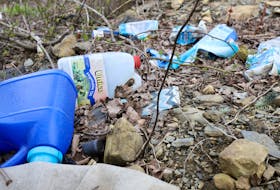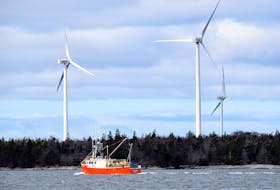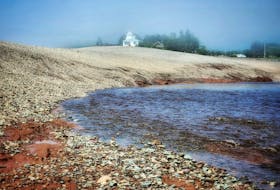Photos posted on Facebook by Jeremy Allard show a dead young blue shark. This was confirmed by Dr. Steven E. Campana of the Bedford Institute of Oceanography.
“Blue sharks are the most common large shark in Canadian waters, but are less frequently seen in the Gulf of St Lawrence, particularly at this time of year,” he said.
Blue sharks are not listed as an endangered species.
The photos were posted to Facebook around 9 p.m. on Sunday night. In the Facebook post, Allard said the shark was about five feet long.
“Looks like this shark may have came in close to shore to give birth and got stranded in low tide.”
The shark carcass was nowhere to be found on Monday.
“We certainly didn’t hear anything about it,” said Matthew Reid, a forestry technician with the Department of Natural Resources. “If it’s within the park boundaries, it’s our responsibility to clean it up.”
He noted that the last marine carcass that DNR had responded to was a 25-foot Minke whale on Piper's Path, Beech Hill Cove in Doctor's Brook, which is near Arisaig, this week.
According to Campana, June to October is the blue shark’s most abundant time in this area.
“Blue sharks are seldom found in waters less than 30 metres deep, so are seldom encountered by swimmers,” he noted. “Even if they are though, they are not a safety concern for Canadian swimmers – there has never been a shark attack on a swimmer in Canadian waters.”
As to why it died, he can only speculate.
“The blood near the mouth suggests that it was hooked by a fisherman and may have died after it was released,” said Campana.
If you spot a dead animal on Melmerby Beach, please contact the Department of Natural Resources.
On Twitter: @NGNewsJohn
Photos posted on Facebook by Jeremy Allard show a dead young blue shark. This was confirmed by Dr. Steven E. Campana of the Bedford Institute of Oceanography.
“Blue sharks are the most common large shark in Canadian waters, but are less frequently seen in the Gulf of St Lawrence, particularly at this time of year,” he said.
Blue sharks are not listed as an endangered species.
The photos were posted to Facebook around 9 p.m. on Sunday night. In the Facebook post, Allard said the shark was about five feet long.
“Looks like this shark may have came in close to shore to give birth and got stranded in low tide.”
The shark carcass was nowhere to be found on Monday.
“We certainly didn’t hear anything about it,” said Matthew Reid, a forestry technician with the Department of Natural Resources. “If it’s within the park boundaries, it’s our responsibility to clean it up.”
He noted that the last marine carcass that DNR had responded to was a 25-foot Minke whale on Piper's Path, Beech Hill Cove in Doctor's Brook, which is near Arisaig, this week.
According to Campana, June to October is the blue shark’s most abundant time in this area.
“Blue sharks are seldom found in waters less than 30 metres deep, so are seldom encountered by swimmers,” he noted. “Even if they are though, they are not a safety concern for Canadian swimmers – there has never been a shark attack on a swimmer in Canadian waters.”
As to why it died, he can only speculate.
“The blood near the mouth suggests that it was hooked by a fisherman and may have died after it was released,” said Campana.
If you spot a dead animal on Melmerby Beach, please contact the Department of Natural Resources.
On Twitter: @NGNewsJohn








